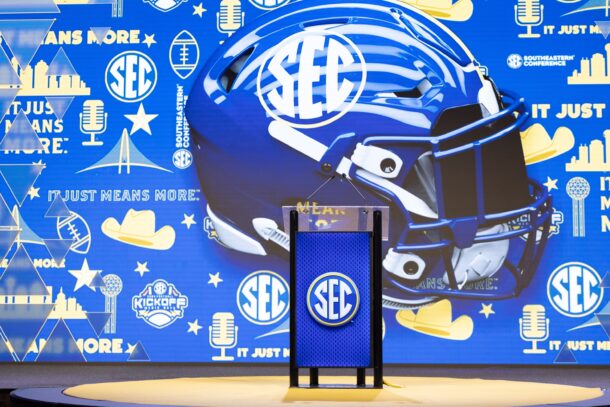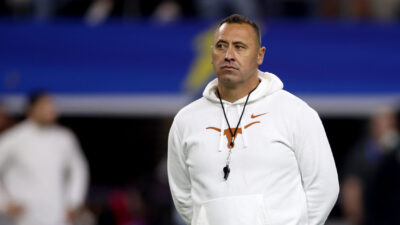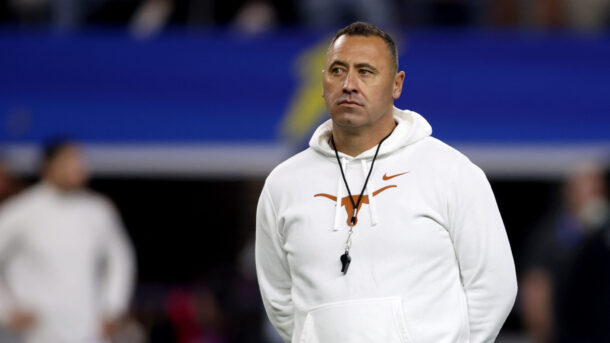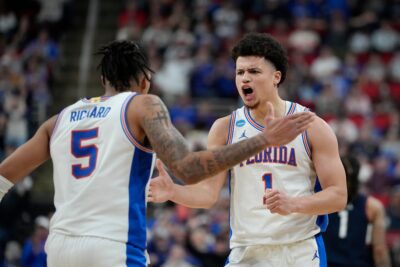Ad Disclosure
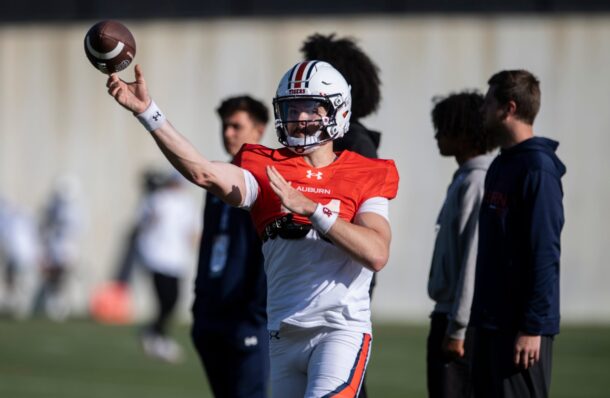
A year ago at this time, Jackson Arnold seemed to have as high of a ceiling as any young quarterback in the country.
A former 5-star prospect, Oklahoma enthusiastically handed him the reins after 2 good-but-not-great seasons from Dillon Gabriel under center.
When fall came, OU waltzed its way through an easy nonconference slate in September and then reality hit when Tennessee came to Norman on Sept. 21. Arnold was benched after a disastrous first half that included numerous missed reads, turnovers and other disasters.
Arnold didn’t reclaim his starting job until Michael Hawkins melted down in similar fashion on Oct. 19 in a blowout home loss to South Carolina. The Sooners parted ways with offensive coordinator Seth Littrell the next day.
But aside from some big numbers against Maine in November, Arnold never really found his footing in Norman. He ended up entering the transfer portal and landed at Auburn, where he’s expected to begin the year as the starter for the 2025 season.
Will things be different for Arnold now that he’s on the Plains?
Will Jackson Arnold rebound at Auburn?
Let’s dive in to what the numbers say about Arnold’s potential moving forward.
What history says about Jackson Arnold’s future
Fair warning: Without context (which we will get to a bit later) the numbers point to a pretty bleak future for Arnold.
Arnold averaged just 5.78 yards per attempt last season on 246 throws. That is historically bad. Looking at Power 5 quarterbacks from 2014 through 2024 (the CFP era), there have only been 14 other quarterbacks who have averaged fewer yards per attempt on that kind of volume of throws.
The list, as you might imagine, doesn’t have many bright spots. Freshman Drew Lock is on there, which gives Arnold something to aim for as he continues his college career. But the list, shown below, is generally filled with quarterbacks who went pro in something other than sports:
That alone is a strong negative indicator as to what Arnold may be able to accomplish in the future. QBs do improve, of course, but history says when they’re that bad over a sample of 240+ attempts, it’s usually not going to end well.
There’s another stat I want to look at when it comes to Arnold: dead-end throw rate. This is something I introduced in a piece discussing why Tennessee should walk away from Nico Iamaleava. It’s rather simple: dead-end throw rate measures how often a QB either throws an incomplete pass or has a completion of 4 yards or less. Dead-end throw rate correlates very well with passer efficiency rating despite not accounting for yards, touchdowns or interceptions.
Arnold, unsurprisingly, had a rather poor dead-end throw rate of 56.1% at Oklahoma last season. The P5 average since 2015 is right around 50%, so his season was about 6 points worse than the average. Arnold ranks 446th out of 504 qualified QB seasons over that span. Only 2 quarterbacks who met the criteria were worse in 2024 (Wisconsin’s Braedyn Locke and Northwestern’s Jack Lausch).
Here’s the company that Arnold was in last season:
What about the context at Oklahoma?
Alright, enough about how bad Jackson Arnold’s stats were last season. Let’s talk about some reasons why Arnold struggled so much at OU.
For starters: OU’s wide receiver room was ravaged by injuries before and during the season. Oklahoma entered fall camp in 2024 with the following players projected to be its top wide receiver options: Deion Burks, Andrel Anthony, Nic Anderson, Jayden Gibson and Jalil Farooq. Those 5 receivers played a grand total of 194 snaps last season, per Pro Football Focus.
Instead, OU relied on receivers like JJ Hester, Brenen Thompson, Jacob Jordan and a few true freshmen. Those were players who, in a perfect world, would have been backups or lightly-tested reserves for OU in 2024. Instead, they were essentially the only targets Arnold had in the passing game.
Oklahoma’s offensive line play was also as bad any team in the SEC. Things improved after Littrell was dismissed, but the Sooners still had one of the worst offensive lines in the league. Per PFF, OU’s OL graded out 12th in pass blocking and 15th in run blocking.
With that context, it shouldn’t be a surprise that Arnold struggled mightily in his first year of college football while his supporting cast was falling apart. It also indicates there might be quite a bit of room for improvement for Arnold if things go well on the Plains.
Reasons for optimism at Auburn
Despite how poor Arnold’s numbers were last season, there’s quite a few reasons for optimism about his 2025 campaign. Simply put, Arnold is getting a massive offensive coordinator upgrade. Going from Littrell to Hugh Freeze alone should put Arnold in position to have a lot more success next season.
I also want to go back to dead-end throw rate for a moment. History says, on average, quarterbacks only improve in dead end throw rate by about 1 point from Year 1 as a starter to Year 2. But there’s quite a bit of volatility in there. For example, Joe Burrow improved by about 15 points between 2018 and 2019 at LSU. The aforementioned Drew Lock went up 10 points between his freshman and sophomore seasons at Mizzou. Will Grier, Haynes King, Drew Allar and Quinn Ewers are all examples of quarterbacks who saw a spike of at least 7 points from Year 1 to Year 2.
It’s certainly possible to have a drastic improvement in dead-end throw rate (and passer efficiency rating), particularly when your situation changes for the better.
I’m expecting that to be the case for Arnold this season. Again, he’s going from Littrell to one of the very best offensive play-callers in the sport in Freeze. Auburn’s wide receiver room also projects to be above average in the SEC as opposed to what OU had a year ago. That unit might even be elite if Cam Coleman takes a big leap. On the offensive line, Auburn brings back its top 4 options from last season and added a couple of transfers this offseason as well.
All that returning production translates into Auburn ranking 21st nationally in Bill Connelly’s offensive returning production formula at a mark of 70%.
Historically, when we’ve seen big spikes in dead-end throw rate efficiency, it’s almost always come with a high returning production ranking — or at least above average. Here’s the corresponding returning production ranking (via Connelly) for every QB who saw a 7+ point DETR improvement from Year 1-to-Year 2 since 2015:
A quick caveat: All 12 of those quarterbacks remained with their same team from Year 1 to Year 2. Arnold’s outlook may look slightly different considering he’s moved teams.
As you can see, 11 of the 12 quarterbacks named in that table were supported by an offense that had at least 70% returning production by Connelly’s formula. The only outlier of the group is Lock, who turned out to an NFL-level talent. Every one else meets (or easily exceeds) the 70% returning production threshold.
While dead-end throw rate is a rather simple stat that seeks to measure how wasteful a quarterback is, it can also shed light on an offense as a whole. Are your receivers dropping too many passes or running bad routes? Do you have to throw the ball away to avoid a sack too often? Are you forced to rely too much on underneath throws to generate completions? Is your offensive coordinator not able to scheme players open as often as his counterparts? At Oklahoma last year, the answer to all of those questions was a resounding “yes.” And Arnold’s efficiency paid the price.
How much of Oklahoma’s offensive ineptitude in 2024 falls at Arnold’s feet? Probably a decent amount. But clearly the context around a quarterback matters. A lot. In Arnold’s case, we’ll find out just how much it mattered after we see whether or not he can rebound at Auburn in 2025.
That is not a guarantee that Arnold is going to see a similar massive spike in efficiency this season. However, the conditions appear to be in place for something like that to occur if Arnold can take advantage of the major upgrades around him.
Spenser is a news editor for Saturday Down South and covers college football across all Saturday Football brands.
